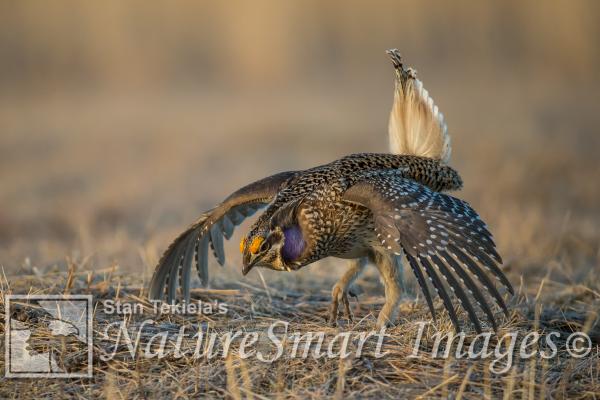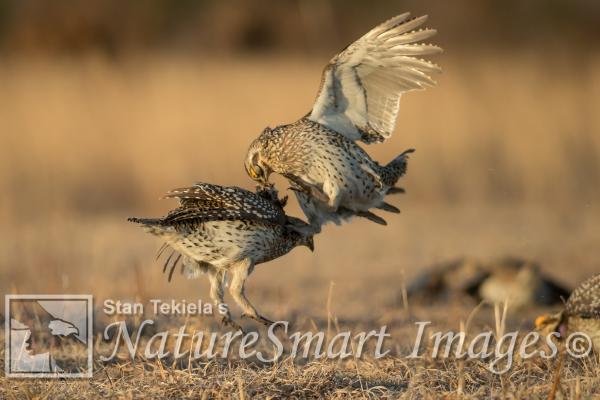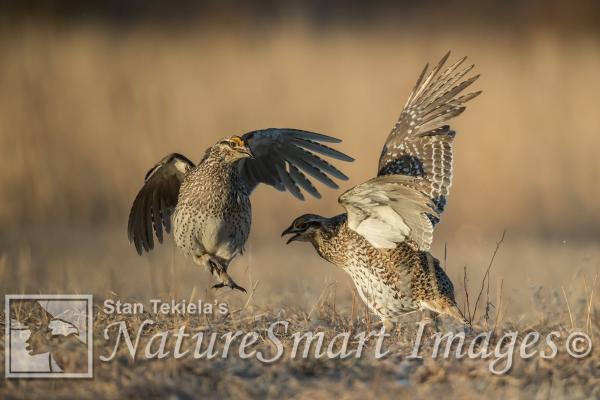View all of the titles in the
NatureSmart Bookstore



by Stan Tekiela
© NatureSmart
June 3, 2017
Driving down a dirt road in the dark, I pull over and put my truck in park. The engine falls silent. It is pitch black outside. The moon had already set, leaving the sky dark and dotted with about a billion twinkling stars. Slowly I gathered up my cameras, tripods, flash cards and extra batteries. Once I had everything packed up, I started walking down the path to the place I had set up my blind the night before.
Thanks to a friend who owns the land, I had scoped out a place to set up my blind and be able to study and film the mating dance/display of the Sharp-tailed Grouse (Tympanuchus phasianellus). Early each spring the male Sharp-tails gather in traditional displaying grounds called a lek. These arenas are traditional which means they are used every year for many decades if not longer. The lek usually has a small clearing of vegetation and sometimes a slight rise in elevation or prominent knoll or rock. However I have seen many leks that didn't have any prominent feature.
When I arrived in the dark the male Sharp-tails were already displaying and calling. How they see anything I don't know. I knew there were over 20 males that congregate at this lek. Slipping into my blind I set up my cameras and sat in the dark waiting for the first light of the day.
Ever-so-slowly the morning sun illuminated the dancing grounds revealing over 20 wonderful sharp-tailed gladiators. These birds don't come to the lek to just dance, they come ready to fight. The more dominant males, the ones with more experience tend to display in the center of the lek. The subordinate males will display around the dominant males.
Once the dancing gets underway, the birds will lean forward and stick their long pointed tail straight up in the air. They cup their wings in a drooping fashion and inflate two purple air sacs on the neck. At the same time they begin to stomp their feet like a child's wind-up toy and spin in circles. Honestly you have to see this display to believe it. It is really amazing.
After a brief time of dancing the birds pair up and face off getting ready to do battle. They face each other and hunker down. One of the males will lunge at the other. The other one fights back and they try to grab each other's feathers, either on the chest, neck or head. Sometimes they grab and hold on so tight that the aggressor gets dragged around by other. As a result feathers go flying.
I worked so hard to capture this incredibly fast action. The birds are jumping, running and spinning so much it's difficult to capture all of the action. As fast as it starts the two opponents are either back to dancing or are facing off getting ready for another battle.
Female Sharp-tails will come to the lek to look and judge the males. What they are looking for we don't understand. Studies show that dominant males are exactly the same size, weight and height as others. So she must be looking for something we can't see.
When the females show up the males stop most of the fighting and put on their dancing shoes. They spin in circles and dance around making all sorts of calls and other sounds. When the females walk amongst the displaying males it really sets off the males displaying. Often times the males will start to chase the female in order to get in front of her so they can see the male better.
Once she has selected the male of her choice they usually fly off together to a nearby location and have a brief encounter. The male quickly returns to the lek and takes up his position again. Interestingly, studies show that while he is gone, the other males don't take up his prime spot.
This intense activity goes on for only an hour or two before all of a sudden the displaying males all fly off together and it's all done for the day. They won't be back until the following morning to do it all over again. Until next time...
Stan Tekiela is an author / naturalist and wildlife photographer who travels the US to study and film wildlife. He can be followed on www.facebook.com and www.twitter.com. He can be contacted via his web page at www.naturesmart.com.
The nationally syndicated NatureSmart Column appears in over 25 cities spanning 7 states: Minnesota, Wisconsin, Michigan, Illinois, Ohio, New York and Pennsylvania. It is a bi-weekly column circulated to over 750,000 readers.
Wolves
Just the day before, a pack of wolves known as the Wapiti, had found a large bull bison that was weak and injured. Based on its size, this big boy was near the end of its lifespan and the winter weather was taking its toll. For a full day the wolves tried to approach the bison but when the bison...
Moose
It was one of those dark and cloudy winter days in Yellowstone National Park where the clouds are so heavy and low, you feel like you can reach up and touch the cloudy sky. A light wind helped to blow the falling snow with occasional gusts of wind causing swirls of fluffy white snow...
American Badger
It’s funny, I believe the average person knows more about the Honey Badger (Mellivora capensis), a critter of Africa and Southwest Asia than they do about the badger in our own backyard, the American Badger (Taxidea taxus). Social media has a lot to do with the Honey Badger phenomena and...
Backyard Bird Feeding
Winter bird feeding is one of the most common / popular hobbies in America. It is estimated that nearly 60 million Americans feed birds in their yards in winter or summer. That is about 40 percent of all American’s make backyard bird feeding part of their everyday activities. It’s...
View all of the titles in the
NatureSmart Bookstore
Check out Stan's latest photos at
NatureSmart Wildlife Images
Take a tour with Stan.
» More Info
Hear Stan on radio stations all across the Midwest.
» More Info

When he's out in the field, Stan relies on his Vortex Razor binoculars and Vortex Razor spotting scope to help find the subjects for his award winning wildlife photography.

For thirty years, professional wildlife photographer Stan Tekiela has counted on Hunt's Photo and Video to provide him with professional photography equipment.
From tripods to camera bodies and lenses, Hunt's has been Stan's place for everything that he needs. Personal service and prompt shipping means Stan can count on Hunt's to support his professional wildlife photography career.


Professional Wildlife Photographer Stan Tekiela always uses Feeder Fresh in his seed feeders to help keep the feeders and food dry, clean and mold free.
He also uses Feeder Fresh Nectar Defender in all of his hummingbird feeders. It safely keeps nectar fresh longer.